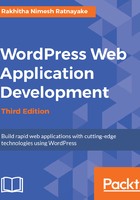
The role of widgets
The official documentation of WordPress refers to widgets as a component that adds content and features to your sidebar. From a typical blogging or CMS user's perspective, it's a completely valid statement. Actually, the widgets offer more in web applications by going beyond the content that populates sidebars. Modern WordPress themes provide a wide range of built-in widgets for advanced functionality, making it much more easier to build applications. The following screenshot shows a typical widgetized sidebar of a website:

We can use dynamic widgetized areas to include complex components as widgets, making it easy to add or remove features without changing source code. The following screenshot shows a sample dynamic widgetized area. We can use the same technique for developing applications with WordPress:

Throughout these sections, we have covered the main components of WordPress and how they fit into the actual web application development. Now we have a good understanding of the components, we can plan our application developed throughout this book.